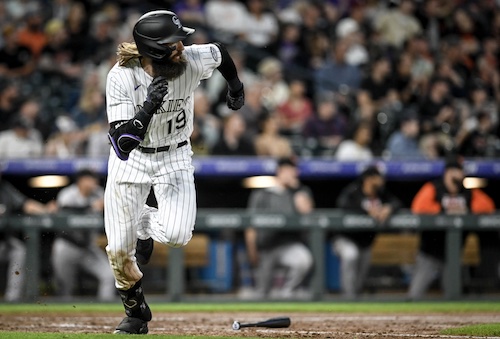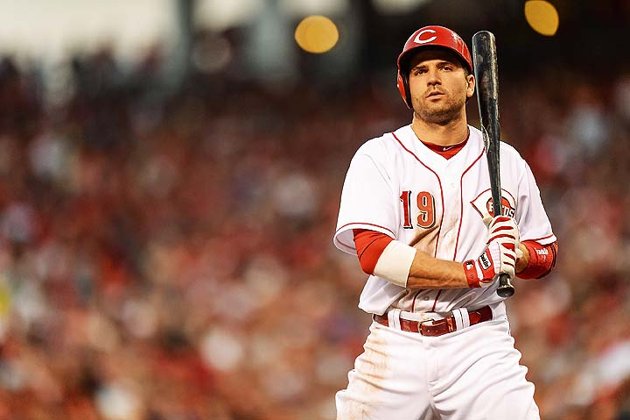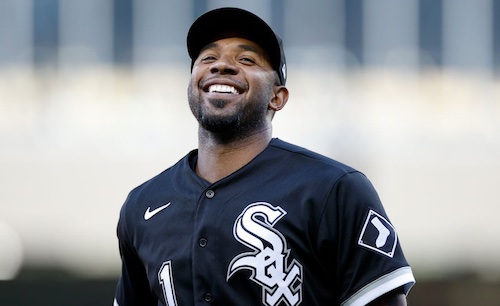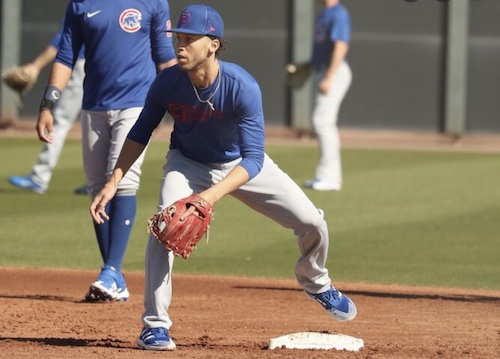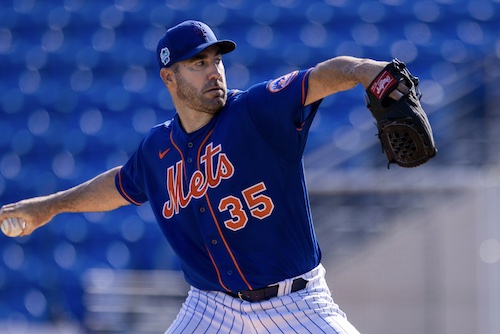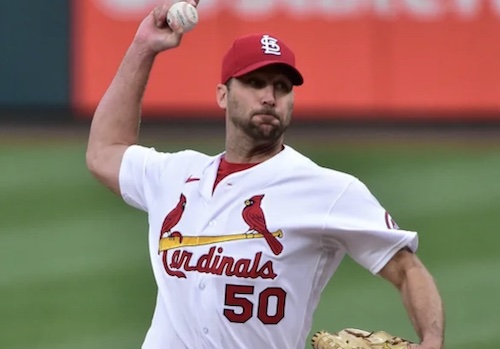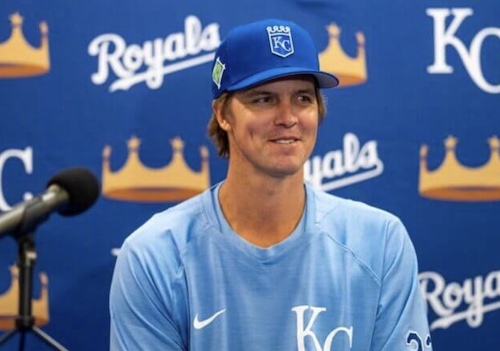Baseball posts
Tuesday October 03, 2023
Brooks Robinson (1937-2023)
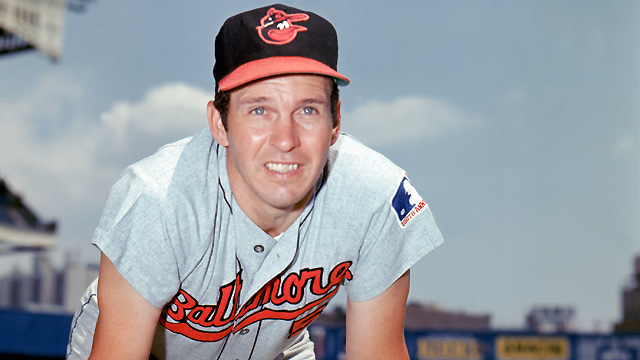
Athletes get better with time. Training gets better, equipment gets better, diet gets better. Today, these guys are doing it 24/7 rather than in their spare time. At the turn of the 20th century, half of Major League Baseball seemed to be hinterland kids avoiding the coal mines who worked at grocery stores in the off-season. Back then, you needed spring training to actually get in shape. Now guys show up in better shape than the rest of the world. That's why amazing plays from the past don't seem so amazing today.
An exception is Brooks Robinson.
Most of his plays in the 1970 World Series are still amazing—particularly the Lee May play. And that play mattered. That often gets lost in the discussion. It was Game 1, Oct. 10, 1970, and while the 108-win Orioles were favorites over the 102-win Cincinnati Reds, the Orioles had been prohibitive favorites the year before against the New York Mets and still lost in five. And they were losing this one, 3-0. Lee May was 2-2, a single and a 2-run homerun—he was making an early argument for MVP—and with the game now tied 3-3 in the sixth (on homeruns by Boog Powell and Elrod Hendricks), he furthered that argument with a lead-off double down the left field line.
Except, oh wait, not a double. The Orioles third baseman, Brooks Robinson, ranged to his right, stabbed the ball, and, from deep in foul territory, heaved a throw over to first base that nabbed May by half a step. (Video here.)
Even today you're like: Holy crap.
Here's how important that play was: The next two guys got on (walk, single) but didn't score. May certainly would've scored ahead of them, and maybe one or both would've scored since there would've been one fewer out against the Reds. But they didn't. And the next inning, the Orioles went ahead on a solo homerun ... by Brooks Robinson. That made it 4-3, Orioles, and that's how the first game ended. The O's wound up winning the Series in five, Brooks Robinson batted .429 with a 1.238 OPS, and made so many great plays at third, robbing the Reds again and again, that afterwards Pete Rose famously said: “Brooks Robinson belongs in a higher league.” He, not Lee May, was named MVP.
And here's the crucial inning on Baseball Reference's play-by-play chart:

Announcer Jim McIntyre: “Great day in the morning, what a play!” The history books: “Groundout: 3B-1B.”
You know who didn't get Pete Rose's memo about Brooksie? Topps. I guess they didn't have much competition back then, and didn't pay much for photographers, so this was Brooks' card the following season, my first real year of collecting cards, along with his World Series card:
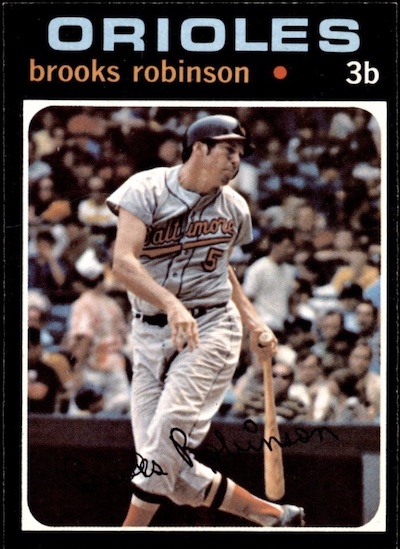
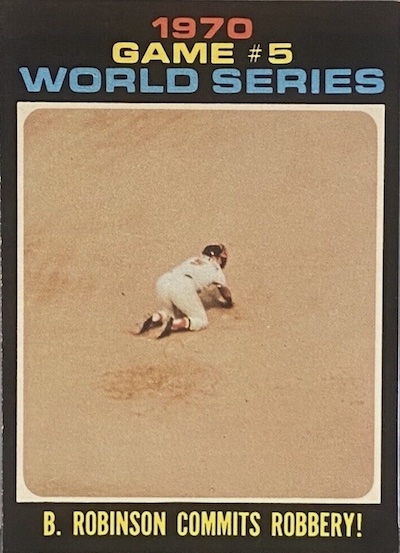
In one he's (I guess?) striking out, in the other ... just what is that? A catcher looking for a contact lens? Someone imitating a turtle? It's like a grainy Bigfoot photo. “We think it's a baseball player but we're not sure.” And it's mostly infield dirt! No one had a zoom back then?
Brooks was my first Brooks—for a time, I actually thought his name was “Brook”—and one of two great Robinsons on the great 1966-71 Orioles team. As a Twins fan, that seemed totally unfair. We'll give you one Hall of Fame Robinson, but two? The other, Frank, won the 1966 World Series MVP, won the 1966 Triple Crown, and hit 586 career homers. It was a time of civil rights, when race was on everybody's mind, and they were asked about it a lot. Hey, two ballplayers, black and white, with the same last name? Surely, you two can solve the implacable American problem. Brooks' go-to was a joke: They were the same height, same weight, but you could tell them apart: “We wear different numbers,” he said. They joked about it in a Miller Lite commercial as well.
Brooks died last week of cardiovascular disease at the age of 86. He was, by all accounts, a beautiful man, open, friendly, classy. I've got a half-dozen quotes about him from Joe Posnanski's obit alone but I'll stick with the best of them. Brooks retired at the end of the 1977 season and they honored him at a banquet. This was shortly after Reggie Jackson hit three homeruns in the final game of the 1977 World Series, and there was a lot of buzz about that. Jackson had said that if he played in New York they'd name a candy bar after him, and now they were going to. And at the banquet, sportswriter Gordon Beard teed that up. He said: “Brooks never asked anyone to name a candy bar after him. In Baltimore, people name their children after him.”
Tuesday October 03, 2023
A Million Ways to Die in the AL West
From Joe Posnanski's end-of-regular-season column, going over the events of the last day—beginning with ...
Astros win again (because of course they do)
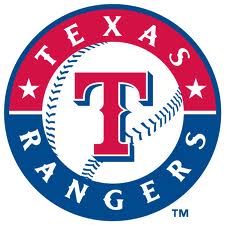 I had this feeling a couple of days ago when Aroldis Chapman had his ninth-inning meltdown, that it would end up costing the Texas Rangers the division title. I didn’t know HOW it would happen — I actually thought the most likely scenario was that the Mariners would sweep the Rangers — but something about that loss and, specifically, the role of Aroldis Chapman in it suggested some bad juju and a crushing finish to what has been a glorious season for the Rangers.
I had this feeling a couple of days ago when Aroldis Chapman had his ninth-inning meltdown, that it would end up costing the Texas Rangers the division title. I didn’t know HOW it would happen — I actually thought the most likely scenario was that the Mariners would sweep the Rangers — but something about that loss and, specifically, the role of Aroldis Chapman in it suggested some bad juju and a crushing finish to what has been a glorious season for the Rangers.
Well, the Mariners did not sweep — the Mariners have their own bad juju to deal with. But they did take three out of four, including Sunday’s gut-punch 1-0 victory, and the Astros woke up just in time to sweep the Diamondbacks (allowing just two runs in the three games) and now the Rangers are stuck trying to win a best-of-three series in Tampa Bay while the Astros get to sip martinis and wait for whoever wins that Twins-Blue Jays series.
Those two are NOT the same thing.
One: It's very cute that Joe thought the Mariners would sweep. He just doesn't know what it's like to be us.
Two: Well, I guess he knows it a little: “the Mariners have their own bad juju to deal with.”
Three: I wrote about all this on Tim's and my Section 327 Substack. Basically: Yay, we kept the Rangers from winning the title! Crap, we let the Astros win the title again! There's no winning, even when we win.
Four: It is astonishing how much those two are not the same thing.
Saturday September 23, 2023
The 40-40 Guys
The ESPN.com headline:
I went through the list in my mind: Canseco, Bonds, A-Rod and ... who was the other? Right. Alfonso Soriano in 2006. Or did I even know that?
Then it hit me: Will Acuna also be the first since the first to win the MVP? Here's how they fared:
- Canseco, 1988, 42 HRs and 40 SBs (16 CS), first in AL MVP in a landslide, with 28 (of 28) first-place votes
- Bonds, 1996, 42 HRs and 40 SBs (7 CS), fifth in NL MVP voting, despite the league's highest bWAR (which obviously didn't exist yet)
- A-Rod, 1998, 42 HRs and 46 SBs (13 CS), ninth in AL MVP voting, despite the league's highest b WAR
- Soriano, 2006, 46 HRs and 41 SBs (17 CS), sixth in NL MVP voting
Interesting that with the exception of Bonds their SB% weren't great. Interesting, too, that with the exception of A-Rod everyone had more homers than SBs.
And now Acuna (thus far):
- Acuna, 2023, 40 HRs and 68 SBs (13 CS)
He's also leading the league in half of all offensive categories but apparently his defense is a little suspect? His bWar is currently 8.0, so he won't approach Bonds' 9.7 bWAR but he has a good shot at A-Rod's 8.5. He's already passed Soriano (6.1) and Canseco (7.3).
Wednesday September 20, 2023
The Boston ... Yankees?
Over on the Substack Section 327 that I do with friend and worldwide webslinger Tim H., I wondered about the MLB teams that have never gone through a name change—either by moving to a different city/state, changing the name of their city/state, or changing their nickname. Like neither Flordia team counts since both made tweaks: Florida Marlins became Miami Marlins (alliterative!) while the Tampa Devil Rays simply became the Rays (meh). I narrowed it down to 11 teams who, soup to nuts, have just been one thing:
- Chicago White Sox
- Detroit Tigers
- Philadelphia Phillies
- Pittsburgh Pirates
- New York Mets
- Kansas City Royals
- San Diego Padres
- Seattle Mariners
- Toronto Blue Jays
- Arizona Diamondbacks
- Colorado Rockies
Tim wondered about some of those original 16 teams, though. Like I discounted the Red Sox because, per Baseball Reference, they'd once been called the Americans: “As I understand it,” Tim wrote, “there's some question whether the Red Sox were ever really the Boston Americans or if they were simply referred to in the papers as such as a shorthand for 'the Boston team of the American League'...”
Thankfully I have that superhandy newspapers.com account which gives you a bit of a glimpse into our past. And I was able to determine that from 1901 to 1906 there were zero references to “Boston Red Sox” (quotes included) in American newspapers, but there were thousands of references to “Boston Americans.”
All that began to change at the tail end of 1907:

Undoubtedly.
The best part was a few grafs down:
“Pres Taylor has suggested red stockings to be a part of the uniforms and thought the Boston 'Red Sox' might sound better to the baseball enthusiasts than the names now used by many, such as 'The Pilgrims,' 'The Yankees,' etc.”
The Boston Yankees???? Wow. It's tough to make two cities simultaneously nauseous but I think that sentence would do it.
Monday September 18, 2023
Poz Wonders Why KC Fans Boo Altuve Over HR Against Yankees
I'm with Joe on this. Mr. Posnanski was at the the Royals-Astros game Saturday and fans were still booing José Altuve, and he was kind of scratching his head:
I mean, on one level, sure, I get it: Many people think Altuve was wearing some sort of sign-stealing buzzer when he hit the pennant-winning home run off an Aroldis Chapman breaking ball in 2019.
What I don't fully get is why people in KANSAS CITY are holding on to that all these years later. ... Whatever he may or may not have done, the Royals are not really involved.
It struck me as odd because everything else about Jose Altuve is so utterly likable. He's tiny — the shortest player in baseball since Kansas City's beloved Freddie Patek — and he plays such a wonderfully joyous game. I mean, he's a lifetime .307 hitter. He already has more than 2,000 hits. He's 5-foot-6, 166 pounds, and he has 209 regular-season home runs and 23 more in the playoffs — that's absurd. Only Joe Morgan, among players around Altuve's size, hit 200 big-league home runs. This guy's a little miracle. ... I just find it kind of weird that Royals fans are still mad at Altuve over a home run that beat the Yankees four years ago.
Amen amen amen. I was shaking my head last July when Seattle fans were booing Astros players during the All-Star game, but added: “I know, the booing won't stop. Mob rule. Once booing becomes a thing, you can't put it back in the bottle.” Even so, I'm with Joe on this, and particularly when it comes to Altuve, whom I, as a charter member of the Short Man's Room, totally cheer for.
Tuesday July 25, 2023
Happy 40th, Pine-Tar Incident

Not so fast, Yankees Baseball Network
Yesterday was the 40th anniversary of the pine-tar incident, when KC Royals third baseman George Brett hit a two-out, two-run homerun off closer Goose Gossage at Yankee Stadium to give the Royals a one-run lead—until, that is, Yankees manager Billy Martin accused him of using a bat with excessive pine tar up the handle and asked the umpires to disqualify him and call him out. Which they did. Which led to Brett storming out of the dugout in insane, eyeball-popping fashion. Which has made for a fun video clip ever since.
Asked by ESPN's William Weinbaum what it's like to be known as the pine-tar guy, Brett responds that everyone's known for something and before that he was known as the hemorrhoids guy (cf., 1980 World Series), so pine tar isn't so bad. Me, I'm like, “Isn't Brett just known as one of the best hitters in baseball history? And one of the last guys to challenge .400? And a great Yankee-killer in the postseason? Plus a handsome SOB?” Let's get our priorities straight, people.
There are two stand-out quotes in their interview for me. The first is Brett describing July 24, 1983:
We were playing the team that I despise the most, the New York Yankees, and they despise me.
Gotta love him for that. The other is when Weinbaum asks him whether he watches the clip much. He says he doesn't seek it out but he doesn't turn away, either. Then this:
Showed it to my kids a whole bunch of times when they were young. I wanted to see the look on their faces when I got mad. I told them, “You better never make me this mad.” And they never did.
Is Brett the greatest Yankee killer of all time? He's in the running—even if his exploits didn't always lead to the Yankees being killed. Royals won the AL West in 1976, '77, '78 and '80, and faced the Yankees in the ALCS each time, and they didn't finally get to the World Series until 1980. But at least that was a sweep.
These are Brett's numbers during those Yankees series:
| Year | G | AB | R | H | 2B | 3B | HR | RBI | BB | SO | BA | OBP | SLG | OPS |
| 1976 | 5 | 18 | 4 | 8 | 1 | 1 | 1 | 5 | 2 | 1 | .444 | .476 | .778 | 1.254 |
| 1977 | 5 | 20 | 2 | 6 | 0 | 2 | 0 | 2 | 1 | 0 | .300 | .333 | .500 | .833 |
| 1978 | 4 | 18 | 7 | 7 | 1 | 1 | 3 | 3 | 0 | 1 | .389 | .389 | 1.056 | 1.444 |
| 1980 | 3 | 11 | 3 | 3 | 1 | 0 | 2 | 4 | 1 | 0 | .273 | .333 | .909 | 1.242 |
| TOTALS | 17 | 67 | 16 | 24 | 3 | 4 | 6 | 14 | 4 | 2 | .358 | .394 | .761 | 1.155 |
Not sure what number I like best: that 1.056 slugging percentage (slugging percentage!) during the '78 ALCS; or the fact that over these 17 games he struck out exactly twice.
For those who don't know: the AL president wound up overruling the umps on the pine-tar call, for not being in the spirit of the rule (pine tar doesn't help you hit homers); the rest of the game was played several weeks later from after the homer, with Brett tossed for rushing the field like a madman, and the Royals won, 5-4. Brett watched the end from an Italian restaurant in New Jersey—another detail from the interview I liked.
Final thought? Billy would've killed for a player like Brett. He was exactly the kind of guy he wanted on his team.
Wednesday July 12, 2023
All the Jerseys at the 2023 All-Star Game

The view from 300 during BP.
The team with the uglier uniforms won. So it goes.
Yesterday I attended my second in-person All-Star Game, at what is now called T-Mobile Park and used to be called Safeco Field, south of downtown Seattle, about 1.5 miles from where I live in the First Hill neighborhood. The last (the only other) ASG I attended was at Safeco, and as I was walking to the game, I ran through all the All-Star Games that played in Minneapolis (where I grew up) and Seattle during my lifetime, and why I hadn't been to more of them.
MINNEAPOLIS
- 1965: Metropolitan Stadium
- 1985: The Hubert H. Humphrey Metrodome
- 2014: Target Field
SEATTLE
- 1979: The Kingdome
- 2001: Safeco Field
- 2023: T-Mobile Park
I missed the first one in Minnesota because I was 2 years old, missed the second because I was in college, studying, and had lost track of baseball for a time. I remember feeling sad that I'd lost track of baseball. Like: What had I become? But look at that list again, there's some interesting history there. Our stadiums once had generic names (“Metropolitan”); then in the 1960s and '70s multi-use stadiums were built and named for famous, powerful people (Humphrey, King, RFK, Shea); but then in the 1990s it was decided, no, retro ballparks subsidized by local governments, with high-priced seating and suites so rich people wouldn't have to intermingle with the rabble, that was the way to go, and while we're at it let's make even more money by selling naming rights to the highest-bidding corporation. And that's where we are. The world keeps turning, and turning bad.
But what sticks out for me is that each of the above ASGs was in a different stadium—except for the two I attended, at Safeco/T-Mobile. How often does an All-Star Game show up at the same stadium within a 25-year span? And that led me to this Wikipedia page on all the MLB All-Star venues, which led me to the realization that I have no idea how they choose the ASG venue. I'd always assumed they just took turns. And if a new stadium was built, well, you go to the head of the line. That first part isn't really true, though. The Tampa Bay Rays, for example, have been around since 1998 and have never hosted—I assume because they have a shitty ballpark. It's MLB going to Tampa, “No, you haven't tried hard enough. You're not helping the brand.”
But if a county builds a new stadium? Damn right we're going to showcase you. The first retro ballpark, Camden Yards in Baltimore, opened in 1992 and hosted the All-Star Game in 1993, and since then, with a few detours to stadiums that were established (Veterans, 1996) or iconic (Fenway, 1999) or iconic and soon-to-be-shuttered (Yankee, 2008), it's been all the retro ballparks, year after year. And then I guess they just ran out. In 2019, the ASG returned to Cleveland and Jacobs/Progressive. In 2021, Coors got a second go-round. In '22 it was iconic Dodger Stadium and now it was Seattle's turn to re-host. Re-hosting at the same stadium with a new corporate name is the new thing. It's what's happening. And I was there for the happening.
Seattle lucked out in showcasing our city, since yesterday was about as perfect a day as you could ask for: mid-70s, blue skies, and the mountains were out. My Philly cousin in LA sent me this email during the game: “Seattle sure looks good on TV. In fact the beauty shots are way more interesting than the game.” I have to admit, there were times, sitting in the 300 level behind homeplate, when a plane went overhead and I'd get lost just looking at its slow trajectory against that vast blueness.
On the ground, not everything was so peachy. Walking there, via the International District and Seahawks parking lot, I ran into crowds on Occidental, as well as one of those miked-up doomsaying preachers. I thought: “Well, at least they pushed him way back here instead of in front of the stadium where he usually is.” Except, nope. He was one of four such preachers I ran into on Occidental. Is there a permit involved when using a microphone for soap-box sermonizing in a public space? I'm curious how it works. I'd be way more interested in these guys if they'd lose the mic. (OK, not too interested.)
And the hawking that I wanted to hear but didn't? Scorecard guys. “Programs, get yer programs!” That was about as staple as baseball use to be, and I would've bought one. But apparently they don't sell them that way anymore. Now it's via the souvenir shops and stands, which may be why the lines there were superlong before the game, and not long at all for the foodstuffs. Me, I bought a brat from my usual guys, ate it in my seat while watching BP, then returned to the 100-level and walked around the park a bit. My favorite thing was checking out all the jerseys everyone was wearing. It wasn't just M's and whatever team we were playing. Everyone was represented, all 30 MLB teams, and then some. My seatmate Andy W. saw an Expos jersey; both of us saw a good 1969 Seattle Pilots number. Hell, Rays fans even showed up, poor bastards. (“Poor” in that they have a smart, winning organization with a shitty ballpark and fanbase.) I saw a Bench 5, and a De La Cruz 44, and a Mets de Grom, and a Jeter 2—along with the usual Griffey 24s, Martinez 11s and Rodriguez 44s. Oh right, I even saw a Yankees 13 for the other Rodriguez, A-Rod. That was intriguing. The most obscure jersey? A Kenji Johjima number. Been a while. If ever.
Two chants got going during the game: “Come-to-Seattle! [clap clap clapclapclap]” whenever Shohei Ohtani batted; and “Sell the team!” whenever the Oakland A's lone rep did anything. That message was for the A's current owner, who is in the midst of shipping the team to Las Vegas, a horrible idea, so I was behind both chants. What I wasn't behind? The continued booing of Astros ballplayers because of the 2017 garbage-can scandal. One, most of the current Astros weren't on that team, so you're booing innocent bystanders. Two, the Mariners weren't going anywhere that year, so it's not like Houston robbed us of anything. And three, who knows, but the cheating might've prevented the New York Yankees from winning the pennant in 2017, which was their best shot at a pennant in the 2010s, so instead they suffered their first pennant-less decade since Babe Ruth was purchased for $100k back in the winter of 1919. C'mon. Anything that prevents the Yankees winning more is a positive. “By any means necessary,” as a great man once said. So stop with the booing already.
(I know, the booing won't stop. Mob rule. Once booing becomes a thing, you can't put it back in the bottle. See: A-Rod.)
We had three Mariners reps this go-round and were lucky to get those. The first one chosen, Luis Castillo, didn't play, but George Kirby pitched an inning (and gave up a run), and Julio Rodriguez, whose jersey I was wearing, played the second half in center field and struck out in the 7th. In the 9th, with the AL down by one, he was the fourth man due up, and the first two guys made outs. The third guy, Kyle Tucker, is an Astro who wasn't around in 2017 but was lustily booed nevertheless. He worked a walk to let us see Julio bat again. (See? Astros can do good things.) Last year, it seemed Julio kept making the magical happen, but this season not so much. He flails too much after the outside sliders and then takes the fastballs in the zone. But here he worked a walk, to get us to Cleveland third baseman Jose Ramirez, who struck out to send us home, a little disappointed but not much.
I was excited to see the youth on the field, all these up-and-comers, so it was interesting that the big blow for the NL was struck by Colorado catcher Elias Diaz, age 32+, a career .249/.302/.391 hitter, playing in his first All-Star Game. Good for him! The scoring began with a Diaz homerun (Yandy, AL, 2nd inning) and ended with a Diaz homerun (Elias, NL, 8th inning), which is a nice bookend. We try to stay neat in Seattle. But I would've preferred it ending with a Rodriguez homerun.
Is that my last All-Star Game in my home park? Probably, unless I move. The year 2001 doesn't seem so long ago in some contexts, but I was 38 then and I'm 60 now. And 60+22 isn't my favorite math.

After the game, fans file past an image of a Diaz who was neither of the Diazes that went yard during the game. (I wish I'd taken more photos of all the jerseys. I like the brave Bonds fan. And the Kyle Lewis wearer has nothing on Kenji.)
Thursday May 25, 2023
Vida Blue (1949-2023)

Charlie Finley was an all-world huckster who had some fun ideas about shaking up the staid old game: those garish, glorious, green-and-gold A's unis; paying his players to grow long hair and facial hair during the hippy-ish early 1970s; manufacturing Old Timey nicknames. All of that was fun. He had shitty ideas, too: orange baseballs, the DH, but I think the worst of them relates to that third fun idea. He'd done well enough with Jim “Catfish” Hunter and John “Blue Moon” Odom, both great, both pure grift, but then he tried to impose the nickname “True” on one of his other young pitchers, and that pitcher balked at the idea. As he should have. Because he already had one of the most perfect names in baseball history. To be honest, I worry a little about Charlie Finley—that when presented with this almost perfect baseball name, nearly a double unique, he didn't see it. He wanted to fuck it up with a false, punny “True.” He didn't see the perfection that was already there in Vida Blue.
For the first half of 1971, when he was just 21 years old, Vida Blue was nearly perfection. He may have been the first superstar to emerge once I became a fan. Everyone else was already there when I showed up: Willie Mays, Hank Aaron, Frank and Brooks Robinson, Harmon Killebrew, Tony Oliva, even the fairly youthful Johnny Bench. But Vida Blue was not there and then, in the spring and summer of 1971, he was everywhere. He was an event.  He was such an event they held a Vida Blue Day for him ... in Minnesota. Twins owner Calvin Griffith was a sad, slow huckster compared to Charlie Finley, but he knew what people wanted, and he knew in the summer of 1971 they wanted Vida Blue. And so for a twi-night doubleheader, the Twins honored the opposing pitcher. In my memory, if you wore a piece of blue clothing you got in for half price, but that doesn't make much sense. Calvin wouldn't take money from Calvin's coffers. No, what you got, if you wore anything blue—and the Twins' promo ad mentioned any apparel, including “suits, dresses, hot pants...” which gives you a sense of the divide in America at the time, when men still wore suits to ballgames while women wore hot pants—what you got, from Calvin on Vida Blue Day at Met Stadium, was a commemorative button, “an attractive blue button,” the ad said, with the following verse:
He was such an event they held a Vida Blue Day for him ... in Minnesota. Twins owner Calvin Griffith was a sad, slow huckster compared to Charlie Finley, but he knew what people wanted, and he knew in the summer of 1971 they wanted Vida Blue. And so for a twi-night doubleheader, the Twins honored the opposing pitcher. In my memory, if you wore a piece of blue clothing you got in for half price, but that doesn't make much sense. Calvin wouldn't take money from Calvin's coffers. No, what you got, if you wore anything blue—and the Twins' promo ad mentioned any apparel, including “suits, dresses, hot pants...” which gives you a sense of the divide in America at the time, when men still wore suits to ballgames while women wore hot pants—what you got, from Calvin on Vida Blue Day at Met Stadium, was a commemorative button, “an attractive blue button,” the ad said, with the following verse:
Rose are red
My clothes were blue
When I was there
To see Vida Blue
Even at age 8, I was like “That's not a rhyme. Blue and blue? That's just the same word.” But we went, wore blue (without trying), got one of those buttons, and saw the Twins win both games against the eventual division winners. Actually, no, we didn't see the victories. I don't know why I still remember this but I do. We arrived late to the first game, missing out on Harmon Killebrew's pinch-hit grand slam in the Twins 9-4 victory, then we left before the end of the second game (“We gotta beat the traffic!” --Frank Costanza and my father), so missed out on George Mitterwald's walk-off homerun against Vida Blue with two outs in the bottom of the 9th as the Twins won 2-1. Two amazing games and we missed out on both big blows. This is why, for the longest time after I became an adult, I never left a game early.
 In that second game, Twins pitcher Hal Haydel got the W for his 9th-inning relief work (one of six Ws in his career), while Vida got the L for the game and went a mere 23-7 on the season. He would wind up 24-8 with a 1.82 ERA, 301 strikeouts to 88 walks in 312 innings pitched, and he would win the Cy Young and the MVP as a 21/22 year old. But the real story was his first half when he went 17-3 with a 1.42 ERA, 17 complete games and six shutouts. Again, that's the first half of the season. He seemed on pace to win 30. He seemed perfection. I'm looking at his game logs for the season and he actually started out poorly, on April 5, giving up 4 runs, 1 earned, in 1 2/3 innings against the lowly Washington Senators. Then he pitched a six-inning rain-shortened shutout against the Royals, striking out 13(!); pitched a complete game shutout of the Brewers; pitched a complete game victory against the ChiSox, and kept going. By the end of May he'd won 10 games (10!), and was on the cover of Sports Illustrated. By the end of August, he was on the cover of Time magazine under the heading “New Zip in the Old Game.”
In that second game, Twins pitcher Hal Haydel got the W for his 9th-inning relief work (one of six Ws in his career), while Vida got the L for the game and went a mere 23-7 on the season. He would wind up 24-8 with a 1.82 ERA, 301 strikeouts to 88 walks in 312 innings pitched, and he would win the Cy Young and the MVP as a 21/22 year old. But the real story was his first half when he went 17-3 with a 1.42 ERA, 17 complete games and six shutouts. Again, that's the first half of the season. He seemed on pace to win 30. He seemed perfection. I'm looking at his game logs for the season and he actually started out poorly, on April 5, giving up 4 runs, 1 earned, in 1 2/3 innings against the lowly Washington Senators. Then he pitched a six-inning rain-shortened shutout against the Royals, striking out 13(!); pitched a complete game shutout of the Brewers; pitched a complete game victory against the ChiSox, and kept going. By the end of May he'd won 10 games (10!), and was on the cover of Sports Illustrated. By the end of August, he was on the cover of Time magazine under the heading “New Zip in the Old Game.”
In the second half, sure, not quite perfection. His ERA rose by a run, to 2.40, and he went 7-5, but there were games that should've been wins. On July 9 against the Angels, he pitched 11 shutout innings, struck out 17 and walked nobody but got the ND. (The A's won it 1-0 in the bottom of the 20th.) Two weeks later, he again went 11, striking out 11 and walking zilch as the A's won it in the bottom of the 12th. But yes, he must've been tiring. His last shutout was August 7 against the ChiSox, his 20th win. In the second half, he was very, very good, but not the Vida Blue of the first half. He was not a comet. But he was beautiful to watch.
Same for the rest of his career. After a season for the ages, he wanted a raise, Finley was penurious, Vida held out. A deal was finally struck ($14.7k —> $63k), but late, so Vida didn't make his first start until the end of May, and though he had a not-bad 2.80 ERA he went 6-10. The next year he won 20, then 17, then 22, as the A's became the only non-Yankees team to win three World Series in a row. In '76 Vida had an ERA of 2.35 and finished sixth in the Cy Young balloting, and was traded midseason to the New York Yankees. Except, whoops, no, another white man, Baseball Commissioner Bowie Kuhn, in perpetual battle with Finley, nullified the deal “in the best interests of baseball.” Back you go. He finally got away from Finley in '78, across the Bay to San Francisco, and became the first pitcher to start for both leagues in the All-Star Game. He lasted until the mid-1980s. Along the way there were drug problems. His career numbers are similar to Catfish Hunter's, but Catfish's rep was different, and Catfish came on the Hall of Fame ballot at the right time, so he got in. Blue, not. His rep was of not quite living up to the promise of that first half of 1971. But how could he? Comets streak across the sky, then disappear from view.
How much does Vida Blue mean to me? A kid who grew up rooting for another team in another state? One evening last November, after I'd returned home from New York City sick with COVID, I was involved in the usual late-night web searching, checking out this and that, and I wound up buying a comfort item for myself, something that just made me feel good. It was that August 1971 Time magazine with Vida Blue on the cover. It's been on my bookshelf ever since. It never doesn't make me smile.
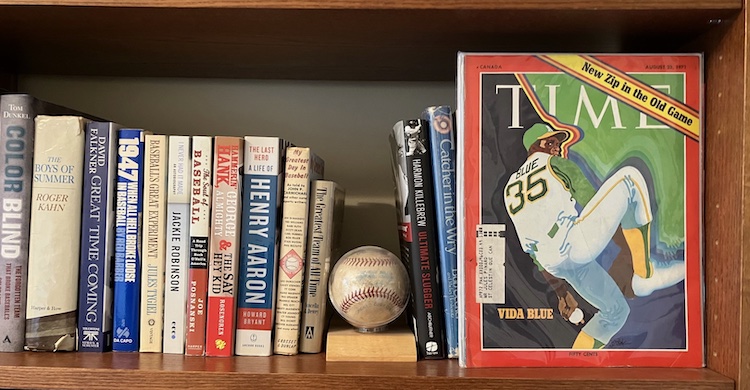
Thursday March 30, 2023
Opening Day 2023: Your Active Leaders
Saturday March 18, 2023
'Duke Snider, Besides Being an Actor...'
I think I came across this particular IMDb absurdity when I was doing research for my review of the Willie Mays doc a few months back. Mays was one of several baseball stars—usually Dodgers or Giants—who made appearances on family-friendly sitcoms in the 1950s and 1960s, and, on IMDb, I was checking exactly who was on what.
I was first struck by this bio:
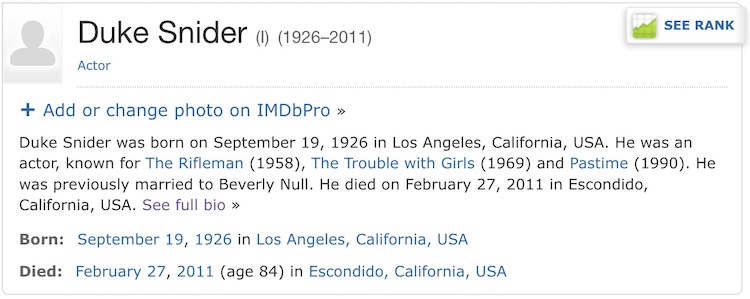
So IMDb thinks Duke Snider was an actor? Known for that one episode of “The Rifleman”?
But of course not. IMDb doesn't think. The above is just a template IMDb/Amazon uses for lesser bios since apparently it's too cheap to hire anyone to write or police any of this. The template goes:
- [Name] was born on [date] in [place].
- He [is/was] an actor, known for [top 3 known fors].
- He is/was married to [wife/former wife].
- If applicable: He died [date] in [place].
That's how IMDb does the bios for Don Drysdale and Willie Mays, too. It's not how they do the bios for other sports stars like Joe Namath (“The son of a steel worker from...”) or Jim Brown (“Often mentioned as the greatest player in NFL history...”), but then both men actually starred in movies. They didn't just make a guest appearance on “The Donna Reed Show.”
Wait, I just checked a couple more. It's also not how they do the bios for Reggie Jackson (“Reggie Jackson is a baseball Hall of Famer nicknamed 'Mr. October'...”) or Ken Griffey Jr. (“Ken Griffey Jr. is considered by many experts to be the best player in baseball...”). And why is Junior's in the present tense, as if he were still playing? As if it were written in 1998 and no one's bothered to update it in IMDb's Amazon era?
Sigh.
Anyway, that's not the part I wanted to bitch about. This is. It's in Duke Snider's trivia section:

Besides being an actor, Duke Snider somehow played baseball, too? Wow. And apparently at a pretty high level!
Seriously, no one's minding the store.
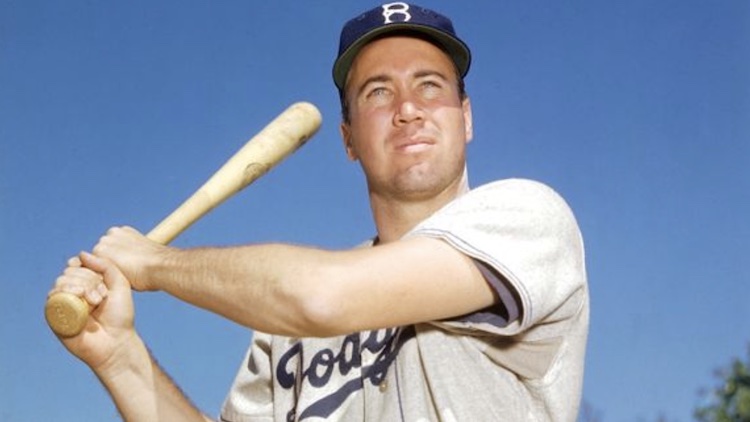
Friday March 10, 2023
The New Timer, the Absence of the Clock, and a Great Pirates Comeback
As soon as I heard about the concept of a “pitch clock” I was against it. Baseball doesn't do clocks. Baseball doesn't do time. Didn't Roger Angell say that? But better?
He did:
“Since baseball time is measured only in outs, all you have to do is succeed utterly; keep hitting, keep the rally alive, and you have defeated time. You remain forever young.”
 He also said this:
He also said this:
“Baseball's clock ticks inwardly and silently, and a man absorbed in a ball game is caught in a slow, green place of removal and concentration and in a tension that is screwed up slowly and ever more tightly with each pitcher's windup and with the almost imperceptible forward lean and little half-step with which the fielders accompany each pitch. Whatever the pace of the particular baseball game we are watching, whatever its outcome, it holds us in its own continuum and mercifully releases us from our own.”
That's beautiful. And now the current lords of Baseball are messing with that beauty. They want to make sure batters step into the box within a certain number of seconds (or get an automatic strike) and pitchers pitch within a certain number of seconds (or get an automatic ball). They tried it out in the minors and this year they're trying it out in the Majors. They're ruining the game!
That's what I thought.
And then I read Joe Posnanski's piece, “Baseball and Time,” in which he was very much in favor of the pitch-clock change. And he won me over. I'm looking forward to the change now.
No. 1, it's increasingly kinda necessary. In my lifetime, games have gotten longer and longer, and players aren't going to police themselves—they'll take what they can get—and so they have to be policed. Apparently spring training games are a half-hour quicker this season: 2.5 hours vs. 3 hours. That's about what it was when I was a kid.
As for Roger Angell's great quote about baseball and time? Poz says it still applies:
But there's a bigger reason I believe both in a pitch clock in baseball and no clock in baseball — it's because I think we're talking about two entirely different things. I don't think the concepts clash at all.
See, by “no clock in baseball,” what I'm really thinking about is not time between pitches. It's all about how outs, not minutes, are the currency of time in the game. That's the magic. ...
If anyone tried to mess with that part of baseball, sure, I'd roar angrily. Three outs in an inning ... nine innings in a game ... this is the most elegant way ever created to time a sport in my view. There is no clock limiting your possibilities. You could be down six runs with two outs in the ninth inning and nobody on base, the way Pittsburgh was against Houston in 2001. If this were an NFL game or NBA game or NHL game or soccer game, there would have been no hope.
But baseball has no clock. And there was hope. And the Pirates came back and won. I'll have more on that game as we get closer to a certain book I've written.
Point is, there's still no clock in baseball. There's now a timer to make sure that guys don't just stand around and halt the forward momentum of the game. But you're still alive until the last out is recorded.
I like that distinction. Here's that Pirates game, btw, when they defeated time and remained forever young.
You know the fun thing about that game? Besides the obvious? After Pat Meares' HR makes it 8-4, the color announcer—is it Bob Walk?—says, “A lot of hoopin' and hollerin', but the horse is already out of the barn.” I probably would've thought the same. No chance for a comeback. But when they do come back, when Brian Giles goes deep to win it, the same color announcer offers a really nice, really smooth mea culpa. “Seven runs in the bottom of the 9th inning, he hits a grand slam homerun off possibly the best closer in baseball ... That is just phenomenal. Well, they went out and found that horse, put a rope around his neck, and let him back in the barn.”
Opening Day is March 30.
Tuesday March 07, 2023
.350 Hitters By Decade
A few weeks ago, in his Pitchers and Catchers report, Joe Posnanski lamented the dearth of 140-RBI seasons by counting out their number per decade since the 1920s, and ending with this:
2011-present: ZERO.
Yeah, that's right: zero. The most RBIs in a season was Miguel Cabrera's 139 in 2012, followed by Chris Davis' 138 in 2013. I love that Chris Davis and Khris Davis have two of the top RBI seasons of the last decade. But the point is that the big RBI seasons have mostly gone away. This is surely because fewer and fewer hitters are getting on base, batting averages have gone way down, Mike Trout and some of the other great hitters in the game can't stay healthy for a full season. But it's a little bit sad. I'm not a fan of using RBIs to judge a player's production, but I admit to getting a little thrill when I see a player with a BIG RBI total.
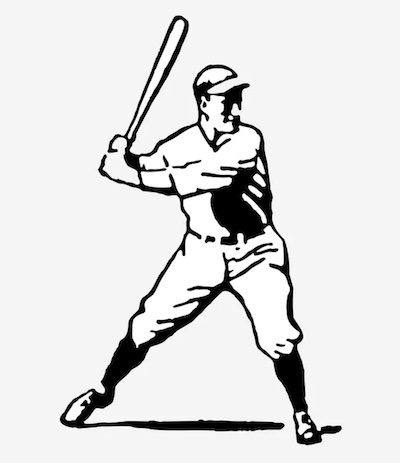 As with me and hitting .350. So I thought I'd do the same. To be honest, I thought I'd already done it, in the post “It's 2018: Do You Know Where Your .350 Hitters Are?” but I'd just counted up dearths, not decades. So here they are by decades:
As with me and hitting .350. So I thought I'd do the same. To be honest, I thought I'd already done it, in the post “It's 2018: Do You Know Where Your .350 Hitters Are?” but I'd just counted up dearths, not decades. So here they are by decades:
- 1900-09: 25, led by Nap Lajoie's .426 in 1901
- 1910-19: 30, led by Ty Cobb's .420 in 1911
- 1920-29: 95!!!!!, led by Rogers Hornsby's .423 in 1924
- 1930-39: 50, led by Bill Terry's .401 in 1930
- 1940-49: 16, led by Ted Williams' .406 in 1941
- 1950-59: 8, led by Ted Williams' .388 in 1957
- 1960-69: 3, led by Norm Cash's .361 in 1961
- 1970-79: 8, led by Rod Carew's .388 in 1977
- 1980-89: 13, led by George Brett's .390 in 1980
- 1990-99: 18, led by Tony Gwynn's .394 in 1994
- 2000-09: 17, led by three players with .372
- 2010-19: 1, Josh Hamilton, .359 in 2010
- 2020-22: 2*, led by D.J. LeMahieu's .364 in 2020
First, how cool is it that Ted Williams had the highest batting average of the 1940s and 1950s? And it wasn't like it was 1949 an 1951. It was 1941 and 1957—a 16-year gap!
Second is that asterisked “2” for the 2020-22 years. Both occurred during the pandemic-shortened year when MLB teams played, at most, 61 games rather than 162. So do we count those? Not really. If you go by a full season, which is kinda what I do, no one's done it since Josh Hamilton in 2010.
But I'm thinking the new rules—particularly the banning of the shift—could swing the pendulum back again. Fingers crossed.
Wednesday March 01, 2023
Posnanski's Cool Thing/Mea Culpa
Here's a cool thing Joe Posnanski is doing. He's got a book out in September, “Why We Love Baseball: A History in 50 Moments,” which, yes, I'm already there. The cool thing is that while it's available from the usual online locales, if you buy it through his favorite local bookstore in Kansas City, Rainy Day Books, he'll not only sign the book for you but inscribe whatever you want:
I will write “Derek Jeter is awesome.” I will write “I agree with Mike Schur on hot fruit.” I will write, “I learned everything I know about baseball from Steve” — assuming your name is Steve.
For those not in the know: 1) He hates Derek Jeter, or just finds him massively overrated (but also underrated at times—no MVPs); 2) He likes hot fruit, as in pies, though his podcast partner is agin with a vengeance; and 3) He knows a lot about baseball. Apparently Poz made this offer with his previous book, too, “The Baseball 100,” and the lesson he learned there is to put a character limit on the inscription: no more than 150 characters. “We had to do it,” he writes; “some of the inscriptions for The Baseball 100 were Russian novels.”
So it's fun + a good cause. So of course I preordered my copy via Rainy Day Books. And this is the inscription I requested:
How Harmon Killebrew went from #67 on my first top 100 list to not making the cut at all I'll never know. What was I thinking?
Nice mea culpa. I'm glad he finally came around on the matter.
Saturday February 25, 2023
Exploding Birds
After counting down the top 100 players in baseball history and writing about the 50 greatest moments in baseball history (to be published in Sept.), Joe Posnanski is now in the midst of creating his very own Hall of Fame, the JoeBlogs Hall of Fame, where the goal is to honor the best and most legendary.
On the latter quality, he spills a few words. Legendary, he says, is...
...something that transcends the field, something that goes beyond the stats, something that isn't always easy to put into words or analysis. Our first class of 13 does not necessarily feature the players who are highest in WAR, though they are certainly all great players. Instead, I'm trying to choose people who in my view best represent that word, “legendary.” These are the players we still tell stories about, the players we will always tell stories about, the players who not only played the game at an exalted level but left us as fans feeling lucky to have seen them play the game.
As for his first class?
|
|
* Beyond the starting eight and three pitchers, Poz chooses two wild cards. Doesn't have to be a player, either. Could be a nonplayer who had a big impact on the game—like Branch Rickey. Oddly, though, if a player, Joe isn't letting us know who the starter is and who the WC is. This first class has four outfielders, including two right fielders. So is Aaron the wild card? Or Ruth? Or Teddy Ballgame, and you move Ruth to left? Feels like a cheat.
 It's a good list, but his most recent player (Schmidt) also feels the least legendary. And it made me wonder if you need time and distance to create a legend. I mean, does “legend” work for contemporaries? Well, Ichiro a bit. Or Griffey. Or Pujols. Then I thought of a guy you could really tell a tall tale around and wrote the following in the comments section:
It's a good list, but his most recent player (Schmidt) also feels the least legendary. And it made me wonder if you need time and distance to create a legend. I mean, does “legend” work for contemporaries? Well, Ichiro a bit. Or Griffey. Or Pujols. Then I thought of a guy you could really tell a tall tale around and wrote the following in the comments section:
“You askin' about Randy Johnson? [Spit] Well, he was as tall as Paul Bunyan, with hair like a waterfall and a fastball that could kill birds in flight. One moment there would be a creature of God, and poof! Just a puff of feathers. His arms was so long he once tagged out a feller on first without leaving the pitching mound. Entire left-handed lineups sat on the bench when he pitched, and half of them retired from baseball rather than face him. Those that did trembled at the plate when they came across his fearsome visage.”
I added: “I mean, only half that stuff is untrue.”
Another reader, piggybacking on that comment, did the same with Nolan Ryan. His recitation was more stats-conscious, less tall tale. I didn't disagree with him, but I responded with the line about Randy I should've used in the first place: Did birds explode when he pitched?
He really does seem out of an American fable: Pecos Bill, John Henry and Randy Johnson.
Sunday February 19, 2023
Tim McCarver (1941-2023)
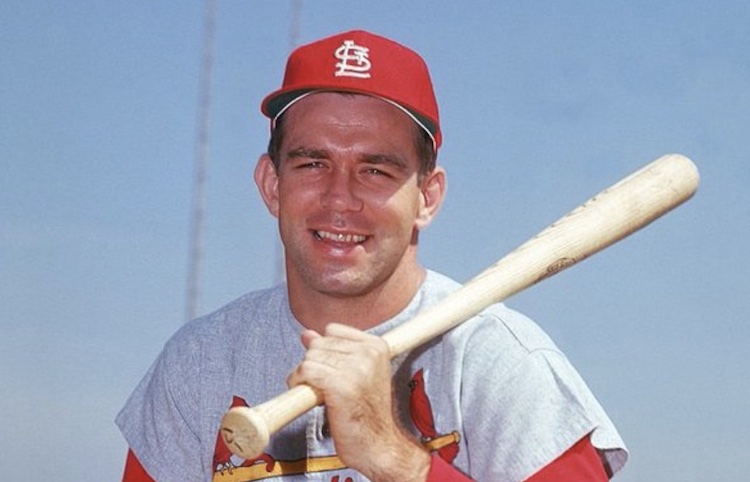
The second thing I thought about when I heard that Tim McCarver died was the way he predicted the Luis Gonzalez bloop single that ended the 2001 World Series. If you hate the Yankees like I hate the Yankees—or the opposite, if you love them—you remember it well.
Yanks had won three World Series in a row, crushed my 116-win pennantless Mariners in the ALCS, and crushed the soul of D-Backs closer Byung-hyun Kim with some late-inning homers in NYC to force a Game 7: Curt Schilling vs. a roided-up Roger Clemens. D-Backs scored first in the 6th (1-0), Yanks answered in the 7th (1-1), then Alfonso Soriano led off the top of the 8th with a solo shot (2-1, Yanks). Which is how it was in the bottom of the 9th when Mariano Rivera came out for his second inning of relief work. For much of the postseason, Joe Torre had gone to him often, and for longer than normal, and maybe it was finally having an effect. We got a leadoff single from Mark Grace, E-1 on an attempted sac bunt, but 1-3 on another attempted sac bunt. (C'mon, Brenley!). But then Tony Womack delivered the killer blow: a ripping double down the right field line to tie the game and put the winning run on third. After Craig Counsell was hit by a pitch to load the bases, Luis Gonzalez came up, and Torre moved the infield in for a play at the plate. And this is what color announcer Tim McCarver said:
“The one problem is Rivera throws inside to lefthanders, so lefthanders get a lot of broken bat hits into shallow outfield ... the shallow part of the outfield. That's the danger of bringing the infield in with a guy like Rivera on the mound.”
And that's exactly what happened. Exactly. And there was joy in Mudville.
McCarver did this kind of thing often. He was smart baseball analyst, who, like all good catchers, kept all of the game in his head, and he was able to articulate that to us. Sure, he sometimes took the air out of the room. Roger Angell began his great 1999 profile of McCarver, “The Bard of the Booth,” by listing off all the complaints he'd heard about McCarver from friends, which amounted to: he talks too much, he laughs and enjoys himself too much, he makes puns, he thinks he's too smart, he is too smart. The complaints were baffling to Angell. Me, too. Give me smart any day of the week. I'm so, so tired of the other.
Joe Posnanski has a nice tribute over on his Substack where he reminds us that, for a time, McCarver looked like a Hall of Famer—particularly after his exemplary 1967 season: .295/.369/.452, while catching a great World Series-winning pitching staff led by Bob Gibson, and finishing second in N.L. MVP voting to teammate Orlando Cepeda. He also caught Gibson's great 1968 Game 1, in which Gibson set a World Series record by striking out 17 Tigers. Overall, in three World Series for the Cards, McCarver hit .311/.384/.500, with two doubles, three triples, two homers and 11 RBIs. In '66, he led the league in triples with 13. That's gotta be a rarity for a catcher.
But the second half of his career, with numerous teams, wasn't like the first, and he was a one-and-done HOF candidate: just 3.8% of the vote.
And here's the first thing I thought about when I heard that Tim McCarver died. In 1995, The New York Times asked him about the most boring part of baseball—I guess because people think it's boring—and he answered not as a broadcaster but as a player. He said it was the small talk first basemen engage in with the base runner:
They'll ask: “How ya hittin' 'em? How's the family?” And they could care less. It's the “Have a nice day” syndrome. I hated it, and Bob Gibson really hated it. One time, against the Expos, Bob got on and Ron Fairly told him, “Hey, you're throwing well.” Fairly came up to bat a couple innings later and Gibson hit him square in the ribs. I think more players ought to retaliate like that.
God, that's perfect. First, it's so Bob Gibson, to shut up a guy by hitting him, but it's also so Ron Fairly, who, in 1995 when I first read this, was the Mariners color announcer, and tended to take the air out of the room. But it's also so Tim McCarver. It's egoless. It's a great baseball story where he's not in it at all. He just wanted to tell a great baseball story.
Rest in peace. Thanks for the call.
All previous entries
Baseball's Active Leaders, 2023
What Trump Said When About COVID
Recent Reviews
Everything Everywhere All at Once (2022)
Black Panther: Wakanda Forever (2022)
Doctor Strange in the Multiverse of Madness (2022)
Spider-Man: No Way Home (2021)
The Cagneys
A Midsummer Night's Dream (1935)
Something to Sing About (1937)
Angels with Dirty Faces (1938)
A Lion Is In the Streets (1953)
Man of a Thousand Faces (1957)
Never Steal Anything Small (1959)
Shake Hands With the Devil (1959)










